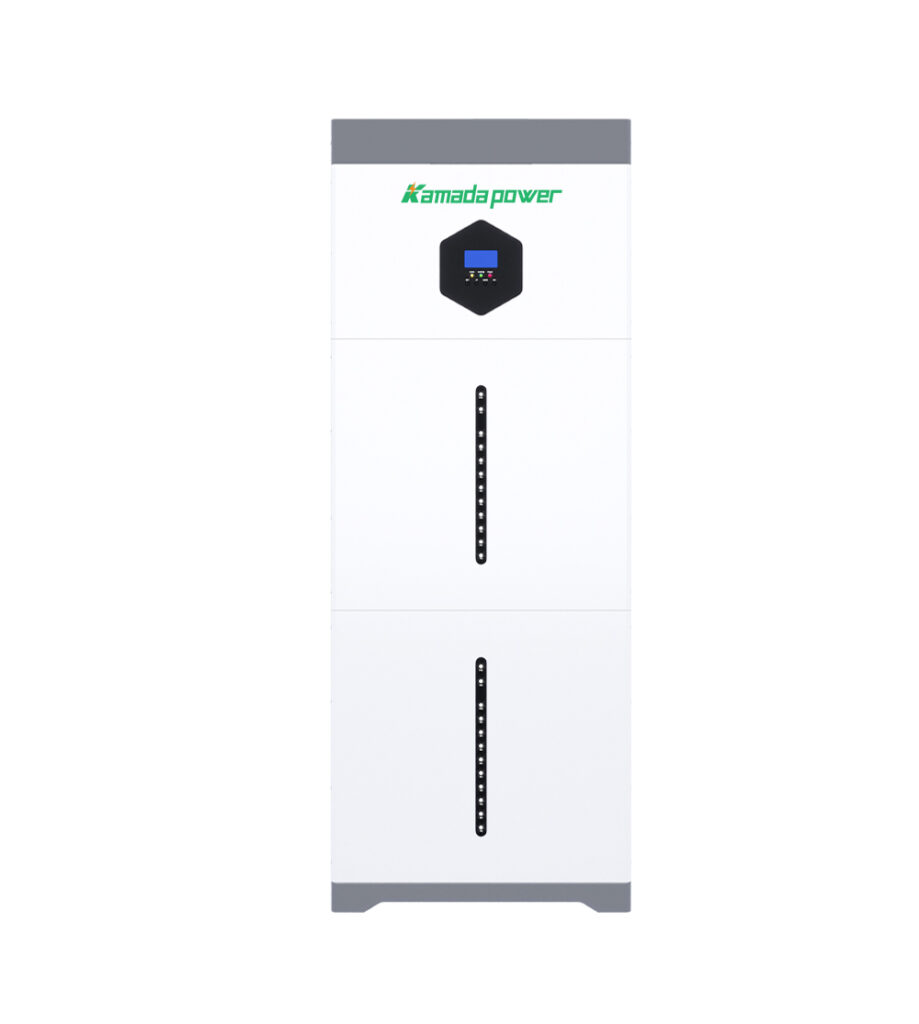本題に入ろう。大金をはたいて屋上に太陽光発電設備を設置した。クリーンな電力を発電しているが、午後5時になると2交代制のシフトが入り、光熱費請求書には大量のピーク需要料金が請求される。さらに悪いことに、先月の短時間の停電があった。生産ラインを2時間ストップさせ、数千ドルの損失を出した。
もしそれがあなたの現実だとしたら、それは太陽電池アレイだけでは半分の解決策にしかならないからだ。頭脳が足りないのだ。エネルギーを貯蔵し、管理し、実際に重要なときに利用できる、考えることのできる装置が必要なのです。それがハイブリッド・インバーターです。
ハードウェアと考えるだけではいけない。エネルギーのコントロールセンターであり、すべての電子の行き先を決定する。アクティブな機械へ、バッテリーへ、あるいはグリッドへ。B2Bのバイヤーや、エネルギー貯蔵から本当のROIを得ようとするエンジニアなら、この機器を誤解するわけにはいかない。

10kWh 電池が付いている 1 つの太陽系インバーターのすべて
ハイブリッド・インバータを理解する
では、実際どのようなものなのでしょうか?ハイブリッド・インバータは、ソーラー・インバータとバッテリー・インバータの仕事を1つのスマートなパッケージに統合したものです。とても単純なことだ。
ハイブリッド・インバータとは?
ハイブリッド・インバータは、ソーラーパネル、バッテリー、送電網からの電力をルーティングする単一の装置です。従来のセットアップでは、それぞれのタスクに別々のボックスが必要でした。ハイブリッド・ユニットはそれをすべて行うため、システムがより効率的になり、より素早く立ち上がります。
コンポーネント
ハイブリッド・インバータの内部では、3つの主要技術が完璧に連動しなければならない:
- インバーター: その主な仕事。パネルとバッテリーからの直流(DC)電力を、建物が実際に稼働する交流(AC)に変換する。
- MPPTチャージコントローラー: 最大電力点追従。これは、雨の日でも晴れの日でも、ソーラーパネルから可能な限りのワットを引き出すために、ソーラーパネルの出力を常に調整するスマートな技術です。アレイの性能を最大限に引き出すことができるのです。
- バッテリー管理システム(BMS)インターフェース: インバーターはバッテリーのBMSと話をしなければなりません。これはオプションではありません。この通信リンクにより、システムはバッテリーを損傷することなく充電と放電を行い、バッテリーの性能を最大限に引き出します。
サイクル寿命.
従来のインバーターとの違い
その違いは、選択肢の有無に尽きる。
- A 系統連系インバーター は一芸に秀でた製品だ。インバーターは太陽光発電の電力を変換し、余った電力を送電網に送る。しかし、送電網がダウンすれば、インバーターは停止しなければならない。あなたは無力だ。
- アン オフグリッド・インバーター これは完全に独立したシステムだ。バッテリーから電力を取り出す方法しか知らない。電力会社とは何の関係もない。
- A ハイブリッド・インバータ は両方の世界を提供してくれる。送電網と連動するだけでなく、停電時には切り離し、太陽光発電とバッテリーから安定したマイクログリッドを作ることもできる。
ハイブリッド・インバータの仕組み
ハイブリッド・インバータの魔法は、そのプログラミング、つまりエネルギーを移動させるためのシンプルなロジックにある。
エネルギーの流れ:太陽光→負荷→バッテリー→グリッド
晴れた日の順位は明らかだ:
- 負荷に電力を供給する: まず第一に、施設を稼働させることだ。利用可能な太陽光発電の電力はすべて、機械、照明、空調に使われます。
- バッテリーを充電する: 負荷がカバーされると、余分な電力は充電に回される。
ナトリウムイオン電池パック またはLiFePO4バンク。
- グリッドにエクスポート: あなたの建物が満足し、バッテリーが満タンになったときだけ、インバーターはわざわざグリッドに電力を送り返す。これが通常、クレジットを獲得する方法である。
停電時の自動負荷優先とバックアップ電源
ハイブリッド・インバータが産業プラントでその威力を発揮するのはここからだ。送電網の故障を感知した瞬間に切り離され、バッテリーからの電力供給が開始されます。切り替えはシームレス。何のためらいもありません。これにより、重要な機器のための真の無停電電源装置(UPS)が構築され、ビジネスが停止することはありません。データセンターにとって、これは贅沢品ではなく、中核的な要件です。
ハイブリッド・インバータの利点
予算を気にする人、運営を心配する人にとって、これらは重要なメリットである。
- エネルギー効率と請求書削減: 安い太陽エネルギーを蓄え、ピーク料金の時間帯に使用することは、電気料金に直接影響する。
- バックアップ電源とUPS機能: 揺れ動くグリッドが引き起こす、コストのかかるダウンタイムを防ぐ。
- 最適化されたバッテリー使用: BMSへのスマートな接続は、バッテリーに費やした費用を保護します。BMSとのスマートな接続により、バッテリーの性能をフルに引き出すことができます。
サイクル寿命 あなたが支払った
- 柔軟性と将来性: 優れたハイブリッド・システムはモジュール式だ。ニーズが増えれば、システムを総入れ替えすることなくバッテリー容量を追加できることが多い。
潜在的な制限と考慮事項
さて、現実の確認だ。どんな技術も銀の弾丸ではない。
- 高いイニシャルコスト: ハイブリッド・インバーターは、基本的な系統連系ユニットよりも初期費用がかかる。それを避けることはできない。長期的な節約と、一度でも大きな停電が発生した場合のコストを天秤にかける必要があります。
- インストールにおける複雑さ: これはDIYのプロジェクトではない。AC/DC電源とバッテリー統合の両方に精通した認定プロが必要なのだ。
- バッテリー互換性: これが大きな問題だ。どんなバッテリーでも配線できるわけではありません。インバーターのファームウェアは、バッテリーのBMSに対して正式に承認されたものでなければなりません。もしそれらが一致しなければ、パフォーマンスが低下し、保証が無効になることは間違いない。間違いありません。
正しいハイブリッド・インバータの選択
適切なモデルを選ぶには、自分たちのオペレーションをよく知る必要がある。
システム・サイズと負荷要件に基づく
小さなオフィスや倉庫で、重い三相電力を使用していませんか? 産業機械?インバータの定格出力(kW)と相出力は、実際の負荷に見合ったサイズでなければなりません。推測は禁物です。
バッテリーの種類と容量に基づく
この選択は非常に重要だ。私たちが現場で目にするのは、化学的性質を仕事の要求に合わせなければならないということだ。
- LiFePO4(リン酸鉄リチウム): これが業界標準なのには理由がある。サイクル寿命、安全性、パワーをしっかりと兼ね備えている。ほとんどの商業用エネルギー貯蔵システム(ESS)にとって実績のある選択肢である。
- ナトリウムイオン: 注目の新技術。A ナトリウムイオン電池 パックはエネルギー密度では劣るかもしれないが、その他の特徴には説得力がある。その安全性は優れており(不燃性)、また 極端な温度性能 は素晴らしい。リチウムイオン電池では壊れるような場所でも使える。厳しい気候の場所や、安全性が絶対的に優先される場所では、検討しなければならない。
ハイブリッドインバーター マスト 選択したバッテリーの特定の充電プロファイルに対応するように作られています。
結論
A ハイブリッドインバータ はアクセサリーではなく、エネルギーシステム全体の価値を解き放つコンポーネントです。パネル、バッテリー、送電網の橋渡しをすることで、電力を実際にコントロールできるようになります。つまり、コストを削減し、稼働時間を保証します。
バッテリーバンクを購入する前に、インバーターを中心にシステムを計画しましょう。制御システムを最初に考えれば、ほとんどの場合、より効果的で弾力性のあるソリューションに行き着くでしょう。
信頼できるLiFePO4とLiFePO4のどちらを選ぶか決めかねている場合 オール・イン・ワン太陽光発電システム そして次世代 ナトリウムイオン電池パック, お問い合わせ.お客様のニーズに合ったインバーターとバッテリーの組み合わせをご提案します。
よくあるご質問
ハイブリッドインバーターと通常のソーラーインバーターの本当の違いは何ですか?
それはバッテリーについてだ。通常のソーラー・インバーターは、太陽光発電の電力をすぐに使えるように変換することだけが仕事だ。ハイブリッド・インバーターはそれを行うだけでなく、バッテリーの充放電を積極的に管理します。こうして、バックアップ電力とスマートなエネルギー利用が可能になるのです。
ハイブリッド・インバーターにはどのメーカーのバッテリーでも接続できますか?
いや、これは重要なポイントだ。インバーターとバッテリーの管理システム(BMS)は、同じデジタル言語を話さなければなりません。インバーターの公式互換性リストを必ず確認してください。インバーターが動作し、保証が有効であることを保証する唯一の方法です。
ハイブリッド・インバータは停電時にも機能しますか?
そう、それがインバーターが存在する最大の理由だ。送電網が暗くなると、インバーターは瞬時に電力線から切り離され、自分のパネルとバッテリーを使用して、自分の施設用に小さく安定した送電網を構築する。
ハイブリッド・インバーターの寿命は?
主要ブランドの高品質インバーターには10年または12年の保証が付きますが、15年以上使えるように設計されています。実際の寿命は、設置品質と使用環境の暑さに大きく左右される。
将来、エネルギー需要が増えたらどうする?
ほとんどの優れたハイブリッド・システムはこのために設計されている。通常、バッテリーモジュールを追加して蓄電量を増やすことができる。システムによっては、複数のインバーターを並列運転して、より大きな出力を得ることもできる。